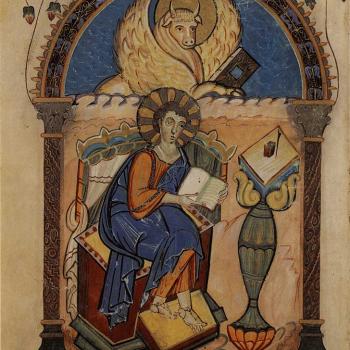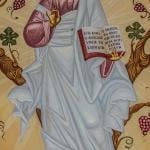

Urban II Preaching the First Crusade
(Wikimedia Commons)
The Historical Context
In the wake of the rise of Islam in the 7th century, the Byzantine Empire lost a lot of territory to Muslim conquests over the following centuries. Not too long after the conversion of the Seljuk Turks in the 10th century to Islam, came their victory over the Byzantines at the Battle of Manzikert in A.D. 1071. In 1074 Pope St. Gregory VII appealed to Western Christians to give military support to the Byzantines, but this amounted to very little.[1]
It should be recalled that the Western Roman Empire fell ca. A.D. 476 with the sack of Rome and the Barbarian incursions into that part of Europe. The Eastern Roman Empire (Byzantium, the Byzantine Empire) survived almost another 1,000 years until it was conquered by the Ottoman Turks in 1453. The Latin speaking West and the Greek speaking East had grown increasingly estranged from one another due to cultural, political, and theological differences from at least the 5th century, until the East-West Schism in 1054.
What is a Crusade?
There seems to be no universal consensus amongst crusade historians as to what a crusade is. Christopher Tyerman’s discussion of the four different views laid out by Giles Constable is helpful here. They are enumerated as follows: traditionalist, pluralist, popularist, and generalist.[2] The first group sees the recovery of Jerusalem as a sine qua non of any crusade whereas the second is broader in its geographical scope, encompassing any campaign that was sanctioned by the Catholic hierarchy, was organized, involved crusader vows, and had crusade privileges attached to it.[3] The criteria become looser as one works through the list. Popularists focus more on “eschatological elements” and view as crusades the more grass roots movements that did not have the sanction of the Catholic Church (such as the Children’s Crusade and the Shepherd’s Crusade), whereas generalists “regard the crusades simply as a holy war, deo auctore [essentially, authored by God]…”[4] Following the late Jonathon Riley-Smith, I hold to the “pluralist” model, but he himself warns that “[m]odern pluralism is a model and models invariably break down when the criteria for them are applied too strictly.”[5] This model allows for campaigns such as the Albigensian Crusade against the Cathars in Southern France, and certain Reconquista campaigns against Muslims in the Iberian Peninsula, to be included in the concept of “crusade.”[6] Thus a crusade can be loosely defined as a form of penitential warfare, sanctioned by the Catholic Church, where the participants took vows and were offered spiritual rewards for fulfilling those vows[7], that was fought in the defense of Christendom.[8]
The First Crusade
Above it was mentioned that Pope Gregory VII’s call for Western Christians to give military aid to the Byzantines amounted to very little in 1074. This was not the case when, in response to an appeal from the Byzantine Emperor Alexius I Comnenus, Pope Urban II called for western arms-bearers to liberate Jerusalem at a Church council in Clermont (France) in 1095. The result of this and the subsequent preaching of the crusade resulted in the mobilization of a sizeable army (as well as of a large number of non-combatants) that marched from Western Europe, through Constantinople, culminating with the capture of Jerusalem. A lot has been skipped over here, and a narrative history is beyond the scope of this short article. This includes the discussion of crusader motives, the preaching of the First Crusade, and the discussion about the oaths procured from the crusader princes by the Byzantine Emperor and the subsequent controversy about who broke them. Nevertheless, the result of the campaign was the presence of Crusader States in the Levant that would last for at least another two centuries. Jerusalem was in Christian hands again, but this would not last indefinitely.
The Second and Third Crusades
On Christmas Eve 1144 the Seljuk Turkish warlord Zengi captured the Crusader State of Edessa. In 1145, Pope Eugenius III issued the papal bull Quantum praedecessores, calling on Christian powers to offer military support in the Levant. The call is taken up by many, including Louis VII, King of France, and Conrad III, King of Germany. At this time as well, campaigns were authorized against Muslims in Iberia, as well as the pagan Wends on the eastern frontier of Germany. The Second Crusade did not succeed in retaking Edessa, nor in capturing Damascus when that became the secondary objective.[9]
This takes us to the Third Crusade, which is perhaps one of the most famous. In 1187, a crusader army was defeated by Saladin, the Ayyūbid Sultan of Egypt, at the Battle of Hattin.[10] Jerusalem was surrendered to him not long after.[11] These events can be seen in Ridley Scott’s 2005 movie, “The Kingdom of Heaven.” The response from the West was the launching of the Third Crusade. A crusader army that was later joined by Phillip II of France and Richard I of England, had some initial success during the lengthy Siege of Acre, when the city was ultimately surrendered after its inhabitants were abandoned by Saladin. Phillip returned to Europe and Richard “the Lionheart” was ultimately unsuccessful in recapturing Jerusalem. Nevertheless, Richard I has been romanticized through the ages and both he and Saladin are popular subjects for Western authors. Saladin, portrayed as a noble and chivalrous character by Western sources down through the ages, seems to have been largely forgotten about in the Muslim sources until more recent times.
The Fourth Crusade and the Albigensian Crusade
Arguably the most controversial crusade was the Fourth Crusade (1204) which, although originally intended to recapture Jerusalem, ended with an army of Venetians and Franks sacking Constantinople. Space does permit the explanation of how exactly this came to be, but Pope Innocent III had not sanctioned it and was initially furious with those involved, as can be seen from his correspondence in the wake of the event. Here, he takes his papal legate to task:
“To Peter, cardinal priest of the title of St. Marcellus, legate of the apostolic see:
…It was your duty to attend to the business of your legation and to give careful consideration, not to the capture of the empire of Constantinople, but rather to the defense of what is left of the Holy Land and, with the Lord’s leave, the restoration of what has been lost.
…How, indeed, is the Greek church to be brought back into ecclesiastical union and to a devotion for the apostolic see when she has been beset with so many afflictions and persecutions that she sees in the Latins only an example of perdition and the works of darkness, so that she now, and with reason, detests the Latins more than dogs?”[12]
The results of the Fourth Crusade were the formation of the Latin Empire of Constantinople, the formation of a Byzantine Empire in exile in Nicaea, and the hardening of the East-West Schism.[13] As Byzantinist Michael Angold points out, one immediate result was that Byzantine identity came to be characterized as being anti-Latin.[14] The sack of Constantinople, the installation of a Latin Patriarch there, and the siphoning off of Byzantine relics to the West still seem to be fresh in the minds of Eastern Orthodox Christians, and the schism, while progress has been made in the last century, still exists.
As Madden and Baldwin point out in their entry on the Albigensian Crusade (1209-1229) in the Encyclopedia Britannica, “heresy…was viewed in the medieval world not as benign religious diversity but rather as a cancerous threat to the salvation of souls. It was held to be even more dangerous than the faraway Muslims, because it harmed the body of Christ from within.”[15] Furthermore, there existed the idea around this time that campaigns to retake Jerusalem were unsuccessful because there were problems to be dealt with at home first.[16] One problem that became apparent to churchmen of the day, and ultimately to Pope Innocent III, was that the Languedoc region of Southern France was infested with heresy, most notoriously a form of dualism known as Catharism, and the secular ruler there (Raymond VI of Tolouse) seemed unwilling to do anything about it. In Medieval Europe, it was seen as the duty of the temporal authorities to suppress heresy in their Catholic realms. Already, the 27th Canon of the Third Lateran Council in 1179 attempted to help remedy the situation in Languedoc. After the papal legate was murdered there about 30 years later, Pope Innocent III launched the Albigensian Crusade. Ultimately, it was unsuccessful in exterminating Catharism in Southern France, and was called off when Innocent wished for campaigns to be focused elsewhere. The Fourth Lateran Council (1215), for example, called for the organization of a crusade to recover the Holy Land (Canon 71.) Heresy in Languedoc was ultimately suppressed by way of inquisition, and the establishment of a University there.
When did the Crusading Movement End?
I have given here a loose chronology from the First Crusade through the Albigensian Crusade when the crusading movement was widely developed. The Fifth and Sixth crusades, the crusades of St. Louis, and more have been omitted. Since there is no universal consensus among crusade historians as to what exactly a crusade is, it should come as no surprise that there is lacking unanimity as to when the crusading movement ended. Was it with the fall of Acre, the last Christian stronghold in the Levant in 1291? In her work “Fidelis Crucis”, the late Sylvia Schein has demonstrated that this is not the case. Was it the Battle of Lepanto in 1571? Again, there seems to be no agreement. According to Jonathon Riley-Smith, the last crusades were in the late 16th century (post-Lepanto), but the movement itself ended in the late eighteenth century.[17] He also notes that due to the influence of churchmen like Francisco de Vitoria, Francisco Suarez, Felipe Ayala, and later others, “[t]he moral theology on which it rested passed out of currency…”[18] This process he breaks down into two stages, through the end of the Napoleonic Wars in the 19th century.[19]
I hope you have enjoyed this primer on the Crusades. Please consider subscribing to the e-mail list to be notified about recent posts.
[1] S. J. Allen and Emilie Amt (eds.), The Crusades: A Reader (Readings in Medieval Civilizations and Cultures) 2nd Edition (Toronto: University of Toronto Press, 2014), 31.
[2] Christopher Tyerman, The Debate on the Crusades, 1099-2010 (Issues in Historiography MUP), (New York: Manchester University Press, 2011), 225-226.
[3] Ibid. pg. 225.
[4] Ibid. pgs. 225-226.
[5] Jonathon Riley-Smith, The Crusades: A History (second edition), (New Haven: Yale University Press, 2005), xxxii.
[6] Ibid.
[7] Christopher Tyerman, The Debate on the Crusades, 1099-2010 (Issues in Historiography MUP), (New York: Manchester University Press, 2011), 225-226.
[8] Jonathon Riley-Smith, The Crusades: A History (second edition), (New Haven: Yale University Press, 2005), xxxi.
[9] Ibid. pgs. 121-129. All of the information from this paragraph comes from here.
[10] https://www.britannica.com/biography/Saladin (accessed 1/2/19)
[11] Ibid.
[12] S. J. Allen and Emilie Amt (eds.), The Crusades: A Reader (Readings in Medieval Civilizations and Cultures) 2nd Edition (Toronto: University of Toronto Press, 2014), pgs. 233-234.
[13] On the last result cf. A. Edward Siecienski, The Papacy and the Orthodox (New York. Oxford University Press, 2017), pg. 282. Also, Francis Dvornik. Byzantium and the Roman Primacy (New York. Fordham University Press, 1966), pg. 167.
[14] Michael Angold, “The Fourth Crusade: Event and Context (Harlow, England. Pearson Education Limited, 2003), pg. 202.
[15] https://www.britannica.com/event/Albigensian-Crusade (accessed 1/2/19)
[16] Jonathon Riley-Smith, The Crusades: A History (second edition), (New Haven: Yale University Press, 2005), pg. 166.
[17] Ibid. Pg. 297.
[18] Ibid.
[19] Ibid. Pgs. 297-298.












